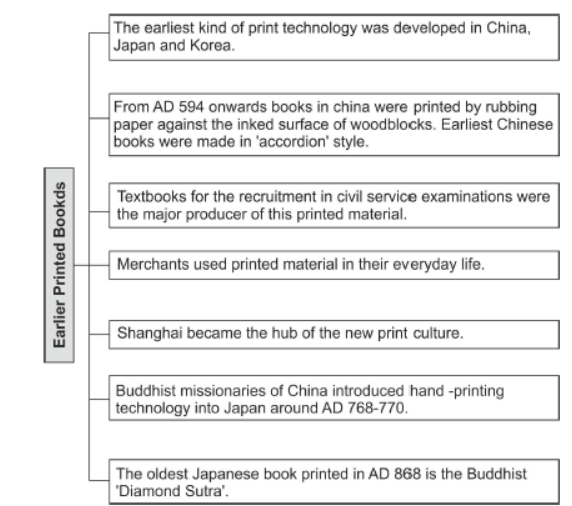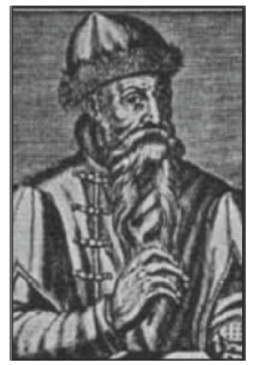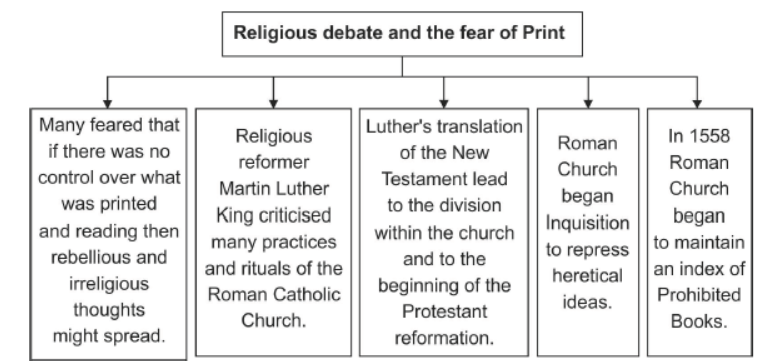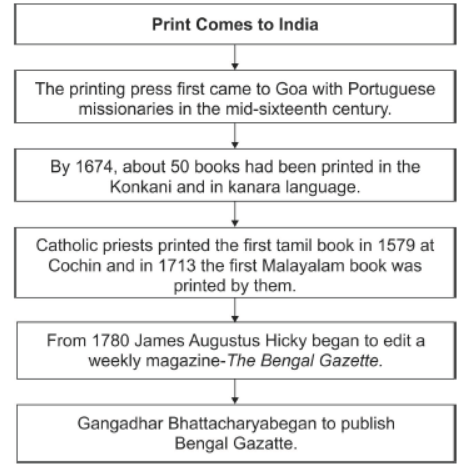Read and download free pdf of CBSE Class 10 Social Science Print Culture and Modern World Assignment Set C. Get printable school Assignments for Class 10 Social Science. Class 10 students should practise questions and answers given here for India And Contemporary World II Chapter 5 Print Culture And The Modern World Social Science in Class 10 which will help them to strengthen their understanding of all important topics. Students should also download free pdf of Printable Worksheets for Class 10 Social Science prepared as per the latest books and syllabus issued by NCERT, CBSE, KVS and do problems daily to score better marks in tests and examinations
Assignment for Class 10 Social Science India And Contemporary World II Chapter 5 Print Culture And The Modern World
Class 10 Social Science students should refer to the following printable assignment in Pdf for India And Contemporary World II Chapter 5 Print Culture And The Modern World in Class 10. This test paper with questions and answers for Class 10 Social Science will be very useful for exams and help you to score good marks
India And Contemporary World II Chapter 5 Print Culture And The Modern World Class 10 Social Science Assignment
Print Culture and The Modern World


Johann Gutenberg
Gutenberg was the son of a merchant and grew up on a large agricultural estate. From his childhood he had seen wine and olive presses. Subsequently he learnt the art of polishing stones became a master goldsmith and also acquired the expertise to create lead moulds used for making trinkets. Drawing on this knowledge he used to design his new innovation. The olive press provided the model for the printing press and the moulds were used for casting the metal types for the letters of the alphabet. By 1448 he perfected this system and the first book he printed was the Bible. Printed books at first closely resembled the written manuscripts in appearance and layout. Between 1450- 1550 printing presses were setup in most countries of Europe.
The print Revolution and its Impact
• With the printing press a new reading public emerged.
• The time and labour required to produce each book came down.
• Cost of books also reduced.
• Books flooded the market reaching out to an ever growing readership.
• Due to print technique a new reading public emerged in place of hearing public.
• Now books could reach out to wider sections of people.
The Reading Mania
• Churches of different denominations set up schools in villages carrying literacy to peasants and artisans.
• In some parts of Europe literacy rate were as high as 60-80%.
• In England, penny chapbooks were carried by petty paddlers known as Chapman.
• In France there was 'Biliotheque bleue' which were low priced small books printed on poor quality paper and bound in cheap blue covers.
• A children Press, devoted to literature for children alone, was setup in France in 1857.
• The Grimm Brothers in Germany spent many years compiling traditional folktales gathered from peasants.
• Lending libraries had been in existence from the seventeenth century onwards.
• In nineteenth century lending libraries in England became instrument for educating white collar workers, artisans and lower middle class people.
• The periodical press developed from 18th century combining information about current affairs with entertainment.
• The writings of Thomas Paine, Voltaire and Jean Jacques Rousseau were also widely printed and read.
• In the 1920s in England, popular works were sold in cheap series called the Shilling Series.
• With the onset of the Great Depression in the 1930s, publishers feared a decline in book purchases. To sustain buying, they brought out cheap paperback editions.
India and the World of Print
• India had a very rich and old tradition of handwritten manuscripts- in Sanskrit, Arabic, and Persian as well as in various vernacular languages.
• Manuscripts were copied on palm leaves or on handmade paper.
• They would be either pressed between wooden covers or sewn together to ensure preservation.
• Even though pre colonial Bengal had developed an extensive network of village primary schools, students very often did not read text.
They only learnt to write. Teachers dictated portions of texts from memory and students wrote them down. Many of them became literate without ever actually reading any kind of texts.

Women, Print and Reform
• The writings of Jane Austen, the Bronte sisters, George Eliot etc became important in defining a new type of woman: a person with will, strength of personality, determination and the power to think.
• Lives and feelings of women began to be written in particularly vivid and intense ways. Women's reading therefore increased enormously in middle class homes.
• Ram Mohan Roy published the Sambad Kaumudi from 1821 and the orthodoxy commissioned the Samachar Chandrika to oppose his opinion.
• From 1822, two Persian newspapers: Jam-i-Jahan Noma and Shamsul Akhbar were published.
• The Deoband Seminari, founded in 1867 published thousands upon thousands of fatwas telling Muslim readers how to conduct themselves in everyday lives and explaining the meaning of Islamic doctrines.
• In 1876 Rashsundari Debi published her autobiography- Amar Jiban.
• In the 1880s Tarabai Shinde and Pandita Ramabai wrote with passionate anger about the miserable lives of upper caste Hindu women, especially widows.
• Ram Chaddha published the fast selling Istri Dharm Vichar to teach women how to be obedient wives.
• In 1871 Jyotiba Phule wrote about the injustice of the caste system in his book Gulamgiri.
• Kashibaba, a Kanpur Mill worker, wrote and published Chote aur Bade ka Saval in 1938 to show the links between caste and class exploitation.
• In 1878, the Vernacular Press Act was passed modeled on the Irish Press Act.
Important Statements
'Printing is the ultimate gift of God and the greatest one' (Martin Luther King)
'Printing press is the most powerful engine of progress and public opinion is the force that will sweep despotism away' (Louis Sabastian Mercier)
Treamble, therefore, tyrants of the world! Tremble before the virtual writer!' (Louis Sabastian Mercier)
New Words
Calligraphy- the art of beautiful and stylised writing is called Calligraphy.
Vellum- A parchment made from the skin of animals.
Platen- It is a board which is pressed onto the back of paper to get the impression from the type.
Compositor- The person who composes the text for printing.
Galley- Metal frame in which types are laid and text composed.
Ballad- A historical account of folk tale in verse usually sung or recited.
Inquisition- A former Roman Catholic court for identifying and punishing heretics.
Heretical- Beliefs which donot follow the accepted teachings of the church.
Sect- A subgroup of a religion.
Chapbook- A term used to describe pocket size books that are sold by travelling peddlers called Chapman in England.
Multiple Choice Questions
Question. What is calligraphy?
(a) Poetry
(b) Textbooks
(c) Flowers arrangement
(d) Stylized
Answer. D
Question. What was Gutenberg’s first printed book?
(a) Ballads
(b) Dictionary
(c) Bible
(d) None of these
Answer. C
Question. What were ‘Penny Chapbooks’?
(a) Pocket – sized books
(b) Journals
(c) Ritual Calendars
(d) Newspaper
Answer. A
Question. Who introduced the printing press in India-
(a) French
(b) Italian
(c) Portuguese
(d) None of these
Answer. C
Question. Who wrote ‘My childhood My university’.
(a) Thomas wood
(b) Maxim Gorky
(c) George Eliot
(d) Jane Austen
Answer. B
Question. When was the Vernacular press act passed?
(a) 1878
(b) 1887
(c) 1867
(d) 1898
Answer. A
Question. Who said, “Printing is the ultimate gift of god and the greatest one.”
(a) Charles Dickens
(b) J. V. Schley
(c) Mahatma Gandhi
(d) Martin Luther
Answer. D
Question. Which is the oldest printed book of Japan
(a) Bible
(b) Diamond Sutra
(c) Mahabharta
(d) Ukiyo
Answer. B
Question. Who wrote 95 theses?
(a) Martin Luther
(b) Johann Gutenberg
(c) J. V. Schley
(d) Charles Dickens
Answer. A
Question. Who authored ‘Gitagovinda’?
(a) Jayadeva
(b) Raja Ram Mohan Roy
(c) J. A. Hickey
(d) Chandu Menon
Answer. A
Very short answer type Questions
Question. Who invented first printing press in Europe?
(a) Martin Luthar King
(b) Johann Gutenberg
(c) Louis Sabestian Marcier
(d) none of the above
Answer. Johann Gutenberg
Question. Rewrite the sentence after correcting the underlined word-Martin Luther King said 'Printing press is the most powerful engine of progress and public opinion is the force that will sweep despotism away'
Answer. Louis Sabestian Marciers
Question. Fill in the blank:
Travelling peddlers in England who sold penny chapbooks were called.................
Answer. Chapman
Question. State True or False for the following sentence-In 1878, the Vernacular
Press Act was passed modeled on the Irish Press Act. Choose the correct match.
(a) Martin Luther King – Japan
(b) Marcopolo – Italy
(c) Louis Sabastian Mercier – Britain
(d) Raja Rammohun Roy – France
Answer. True
Question. In the question given below, there are two statements marked as Assertion
(A) and Reason (R). Read the statement and choose the correct option:
Assertion (A): Due to Print revolution the listening public converted into reading public.
Reason (R): Now books had reached wider sections of society.
Option
(a) Both A and R are true and R is the correct explanation of
(b) Both A and R are true and but R is not the correct explanation of
(d) A is correct and R is Incorrect.
(d) A is incorrect but R is correct.
Answer. A
Question. In the question given below, there are two statements marked as Assertion (A) and Reason (R). Read the statement and choose the correct option:
Assertion (A): The oldest Japanese book the 'Diamond Sutra' printed in AD 868.
Reason (R): Buddhist missionaries from China introduced printing technology into Japan around AD 768-770.
Option
(a) Both A and R are true and R is the correct explanation of
(b) Both A and R are true and but R is not the correct explanation of
(c) A is correct and R is Incorrect.
(d) A is incorrect but R is correct.
Answer. A
Question. In the question given below, there are two statements marked as Assertion
(A) and Reason (R). Read the statement and choose the correct option:
Assertion (A): Manuscripts were pressed between wooden covers or sewn together to ensure preservation..
Reason (R): Manuscripts were copied on palm leaves or on handmade paper.
Option
(a) Both A and R are true and R is the correct explanation of
(b) Both A and R are true and but R is not the correct explanation of
(c) A is correct and R is Incorrect.
(d) A is incorrect but R is correct.
Answer. A
Question. Which was the first book printed by Johann Gutenberg?
Answer. Bible
Question. What is the theme of the book 'Gulamgiri'?
Answer. Against caste System
Question. Who brought woodblock printing technology to Europe?
Answer. Marco polo
Question. In which country printing technology was first developed?
Answer. China
Question. Which edition of books was given more importance to tackle the problem of great depression?
Answer. Paperback edition
Question. What do you understand by wood-block printing?
Answer. Rubbing paper against the inked surface of woodblocks
Question. Define Fatwa.
Answer. A legal pronouncement on Islamic law usually given by a mufti (legal scholar) to clarify issues on which the law is uncertain.
Question. Define Ulema.
Answer. Legal scholars of Islam and the sharia (a body of Islamic law)
Question. Name two Persian newspapers which were published in 1882.
Answer. Jam-i-Jahan Nama and Shamsul Akhbar
Question. Who brought printing technique to India and when?
Answer. Portuguese, 16th Century
Question. What is meant by 'Reformation'?
Answer. Religious reform in Roman Catholic Church
Question. Which was the first newspaper of India?
Answer. Bengal gazette
Question. Explain any three features of handwritten manuscripts before the age of print in India?
Answer.
1. They were copied on palm leaves or on handmade papers.
2. Pages were beautifully illustrated.
3. They were pressed between wooden covers or sewn together to ensure preservation.
4. Manuscripts were available in vernacular languages.
5. Highly expensive & fragile.
6. They could not be read easily as script was written in different styles.
7. They were not widely used in everyday life.
Question. Why did the woodblock method become popular in Europe?
Answer.
1. Production of handwritten manuscripts could not meet the ever increasing demand for books.
2. Copying was an expensive, laborious and time consuming business.
3. The manuscripts were fragile, awkward to handle and could not be carried around or read easily.
4. By the early 15th century, woodblocks started being widely used in Europe to print textiles, playing cards and religious pictures with simple, brief texts.
Question. What was the role of new ‘visual image’ culture in printing in India?
Answer.
1. In the end of 19th century a new visual culture had started.
2. With the increasing number of printing presses visual images could be easily reproduced in multiple copies.
3. Painters like ‘Raja Ravi Verma’ produced images for mass circulation. Cheap prints and calendars were brought even by the poor to decorate the walls of their houses.
Question. “Print popularized the ideas of the idea of the enlightenment thinkers.” Explain.
Answer.
1. Collectively the writings of thinkers provided a critical commentary on tradition, superstition and despotism.
2. Scholars and thinkers argued for the rule of reason rather than custom and demanded that everything to be judged through the application of reason and rationality.
3. They attacked the sacred authority of the church and the despotic power of the state thus eroding the legitimacy of a social order based on tradition.
4. The writing of Voltaire and Rousseau were read widely and those who read world through new eyes, eyes that were questioning critical and rational.
Long Answer type Questions
Question. How print revolution led to the development of reading mania in Europe.
Answer. As literacy and schools spread in European countries there was a virtual reading mania.
1. A new forms of popular literature appeared to target new readers
2. There were ritual calendars along with ballads and folk tales.
3. In England penny chapbooks were carried by petty peddlers known as chapmen and sold for a penny, So that even poor could buy them.
4. In France these law priced books were called Bibliotheque Bleue as they were bound in cheap blue covers.
5. There were romances, histories, books of various sixes, serving developed to combine information on current affairs with entertainment.
6. Periodical pressed developed to combine information on current affairs with entertainment.
7. The idea of scientists and scholars had now become more accessible to the common people.
Question. How did oral culture enter print and how was the printed material transmitted orally? Explain
Answer. Oral culture entered print into the following ways –
1. Printers published popular ballads and folktales.
2. Books were profusely illustrated with pictures. Printed material was transmitted orally in the following ways.
I. These were sung at gathering in villages, taverns and in towns.
II. They were recited in public gathering.
Question. Explain the impact of print on Indian women.
Answer.
1. Writers started writing about the lives and features of women and this increased the number of women readers.
2. Women writers write their own autobiography. They highlighted the condition of women, their ignorance and how they forced to do hard domestic labour.
3. A large section of Hindu writing was devoted to the education of women.
4. In the early 20th century the journals written by women become very popular in which women’s education, widowhood, widow remarriage were discussed.
5. Many writers published how to teach women to be obedient wives.
Question. By the end of the 19th century a new visual cultural was taking shapes. Write any three features of this new visual cultural.
Answer.
1. Visual images could be easily reproduced in multiple copies.
2. Printers produced images for mass circulation cheap prints and calendars could be brought even by the poor.
3. By the 1870’s caricatures and cartoons were being published in journals and news papers.
4. Mass production of cost and visual images reduced the cost of production. So cheap prints and calendars were available in the market even for the poor to decorate the walls of their homes.
Question. ‘Many Histories have argued that print culture created the conditions within which the French Revolution occurred.’ Explain.
Answer.
1. The print popularized the ideas of the enlightened thinkers who attacked the authority of the church and the despotic power of the state.
2. The print created a new culture of dialogue and debate and the public become aware of reasoning. They recognized the need to question the existing ideas and beliefs.
3. The literature of 1780’s mocked the royalty and criticized their morality and the existing social order. This literature led to the growth of hostile sentiments against.
Question. What steps were taken by the Britishers to curtail the freedom of press in India?
Answer. After the 1857 revolt angry Britishers sought for control on press.
• Vernacular Press Act was passed in 1878
• Reports of vernacular newspapers were censored
• Government kept regular track of the newspapers.
• Even the assets of press were confiscated.
Source Based Questions(4 Marks)
1. Read the extract and answer the following questions-
The earliest kind of print technology was developed in China, Japan and Korea. This was a system of hand printing. From AD 594 onwards, books in China were printed by rubbing paper - also invented there - against the inked surface of woodblocks. As both sides of the thin, porous sheet could not be printed, the traditional Chinese 'accordion book' was folded and stitched at the side. Superbly skilled craftsmen could duplicate, with remarkable accuracy, the beauty of calligraphy. The imperial state in China was, for a very long time, the major producer of printed material. China possessed a huge bureaucratic system which recruited its personnel through civil service examinations. Textbooks for this examination were printed in vast numbers under the sponsorship of the imperial state. From the sixteenth century, the number of examination candidates went up and that increased the volume of print.
Question. Which of the following country did not have printing technique in the beginning?
(a) India
(b) China
(c) Japan
(d) Korea
Answer. India
Question. What do you understand by the 'Accordion style'?
Answer. Folded and stitched to me side.
Question. Why did China publish printed material on large scale?
Answer. For printing examination material for civil serives enamination.
Question. What was the work of calligraphers?
Answer. They were the people who were expent is the art of beautiful and stylised sriting.
| CBSE Class 10 Social Science History The Rise Of Nationalism In Europe Assignment |
| CBSE Class 10 Social Science History The Rise Of Nationalism In Europe Hindi Assignment |
| CBSE Class 10 Social Science The Rise Of Nationalism In Europe Assignment |
| CBSE Class 10 Social Science Economics Consumer Rights Assignment |
| CBSE Class 10 Social Science Economics Consumer Rights Hindi Assignment |
CBSE Class 10 Social Science India And Contemporary World II Chapter 5 Print Culture And The Modern World Assignment
We hope you liked the above assignment for India And Contemporary World II Chapter 5 Print Culture And The Modern World which has been designed as per the latest syllabus for Class 10 Social Science released by CBSE. Students of Class 10 should download and practice the above Assignments for Class 10 Social Science regularly. We have provided all types of questions like MCQs, short answer questions, objective questions and long answer questions in the Class 10 Social Science practice sheet in Pdf. All questions have been designed for Social Science by looking into the pattern of problems asked in previous year examinations. You can download all Revision notes for Class 10 Social Science also absolutely free of cost. Lot of MCQ questions for Class 10 Social Science have also been given in the worksheets and assignments for regular use. All study material for Class 10 Social Science students have been given on studiestoday. We have also provided lot of Worksheets for Class 10 Social Science which you can use to further make your self stronger in Social Science.
What are benefits of doing Assignment for CBSE Class 10 Social Science India And Contemporary World II Chapter 5 Print Culture And The Modern World?
a. Score higher marks: Regular practice of Social Science Class 10 Assignments for chapter India And Contemporary World II Chapter 5 Print Culture And The Modern World will help to improve understanding and help in solving exam questions correctly.
b. As per CBSE pattern: All questions given above follow the latest Class 10 Social Science Sample Papers so that students can prepare as per latest exam pattern.
c. Understand different question types: These assignments include MCQ Questions for Class 10 Social Science with answers relating to India And Contemporary World II Chapter 5 Print Culture And The Modern World, short answers, long answers, and also case studies.
d. Improve time management: Daily solving questions from India And Contemporary World II Chapter 5 Print Culture And The Modern World within a set time will improve your speed and accuracy.
e. Boost confidence: Practicing multiple assignments and Class 10 Social Science mock tests for India And Contemporary World II Chapter 5 Print Culture And The Modern World reduces exam stress.
How to Solve CBSE Class 10 Social Science India And Contemporary World II Chapter 5 Print Culture And The Modern World Assignment effectively?
a. Start with Class 10 NCERT and syllabus topics: Always read the chapter carefully before attempting Assignment questions for Class 10 Social Science India And Contemporary World II Chapter 5 Print Culture And The Modern World.
b. Solve without checking answers: You should first attempt the assignment questions on India And Contemporary World II Chapter 5 Print Culture And The Modern World yourself and then compare with provided solutions.
c. Use Class 10 worksheets and revision notes: Refer to NCERT Class 10 Social Science worksheets, sample papers, and mock tests for extra practice.
d. Revise tricky topics: Focus on difficult concepts by solving Class 10 Social Science MCQ Test.
e. Maintain notebook: Note down mistakes in India And Contemporary World II Chapter 5 Print Culture And The Modern World assignment and read them in Revision notes for Class 10 Social Science
How to practice CBSE Class 10 Social Science India And Contemporary World II Chapter 5 Print Culture And The Modern World Assignment for best results?
a. Solve assignments daily: Regular practice of India And Contemporary World II Chapter 5 Print Culture And The Modern World questions will strengthen problem solving skills.
b.Use Class 10 study materials: Combine NCERT book for Class 10 Social Science, mock tests, sample papers, and worksheets to get a complete preparation experience.
c. Set a timer: Practicing Class 10 Social Science India And Contemporary World II Chapter 5 Print Culture And The Modern World assignment under timed conditions improves speed and accuracy.
You can download free Pdf assignments for CBSE Class 10 Social Science India And Contemporary World II Chapter 5 Print Culture And The Modern World from StudiesToday.com
All topics given in India And Contemporary World II Chapter 5 Print Culture And The Modern World Social Science Class 10 Book for the current academic year have been covered in the given assignment
No, all Printable Assignments for India And Contemporary World II Chapter 5 Print Culture And The Modern World Class 10 Social Science have been given for free and can be downloaded in Pdf format
Latest syllabus issued for current academic year by CBSE has been used to design assignments for India And Contemporary World II Chapter 5 Print Culture And The Modern World Class 10
Yes, we have provided detailed answers for all questions given in assignments for India And Contemporary World II Chapter 5 Print Culture And The Modern World Class 10 Social Science

